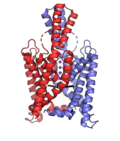Two-pore-domain potassium channel
Two-pore-domain potassium channel[edit]



Two-pore-domain potassium channels, also known as K2P channels, are a class of potassium channels that are characterized by having two pore-forming domains in each subunit. These channels are responsible for setting and regulating the resting membrane potential of cells and are involved in various physiological processes.
Structure[edit]
K2P channels are unique among potassium channels due to their structure, which includes two pore-forming domains per subunit. This structural feature allows them to form dimers, creating a functional channel with four pore domains. The channels are generally composed of four transmembrane segments and two pore loops, which contribute to the selectivity filter that allows potassium ions to pass through while excluding other ions.
Function[edit]
The primary function of two-pore-domain potassium channels is to maintain the resting membrane potential and contribute to the background potassium conductance in cells. They are often referred to as "leak" channels because they allow a constant, passive flow of potassium ions across the cell membrane. This flow is crucial for stabilizing the membrane potential and modulating cellular excitability.
K2P channels are involved in various physiological processes, including neuronal excitability, cardiac function, and pain perception. They are also sensitive to a range of physical and chemical stimuli, such as changes in pH, temperature, and mechanical stretch, which can modulate their activity.
Types[edit]
There are several subfamilies of K2P channels, each with distinct properties and regulatory mechanisms. Some of the well-known subfamilies include:
- K2P1 (TWIK-1): The first identified member of the K2P family, involved in setting the resting membrane potential.
- K2P2 (TREK-1): Known for its sensitivity to mechanical stretch and temperature changes.
- K2P3 (TASK-1): Plays a role in pH sensing and is involved in respiratory control.
Clinical significance[edit]
Mutations and dysregulation of K2P channels have been implicated in various diseases, including neurological disorders, cardiac arrhythmias, and cancer. As such, they are considered potential targets for therapeutic intervention.
Related pages[edit]
References[edit]
<references group="" responsive="1"></references>
Two-pore-domain potassium channel[edit]
-
Two-pore-domain potassium channel K2P1 structure
-
Two-pore-domain potassium channel K2P2 structure
-
Two-pore-domain potassium channel K2P3 structure
Ad. Transform your life with W8MD's Budget GLP-1 injections from $75


W8MD offers a medical weight loss program to lose weight in Philadelphia. Our physician-supervised medical weight loss provides:
- Weight loss injections in NYC (generic and brand names):
- Zepbound / Mounjaro, Wegovy / Ozempic, Saxenda
- Most insurances accepted or discounted self-pay rates. We will obtain insurance prior authorizations if needed.
- Generic GLP1 weight loss injections from $75 for the starting dose.
- Also offer prescription weight loss medications including Phentermine, Qsymia, Diethylpropion, Contrave etc.
NYC weight loss doctor appointmentsNYC weight loss doctor appointments
Start your NYC weight loss journey today at our NYC medical weight loss and Philadelphia medical weight loss clinics.
- Call 718-946-5500 to lose weight in NYC or for medical weight loss in Philadelphia 215-676-2334.
- Tags:NYC medical weight loss, Philadelphia lose weight Zepbound NYC, Budget GLP1 weight loss injections, Wegovy Philadelphia, Wegovy NYC, Philadelphia medical weight loss, Brookly weight loss and Wegovy NYC
|
WikiMD's Wellness Encyclopedia |
| Let Food Be Thy Medicine Medicine Thy Food - Hippocrates |
Medical Disclaimer: WikiMD is not a substitute for professional medical advice. The information on WikiMD is provided as an information resource only, may be incorrect, outdated or misleading, and is not to be used or relied on for any diagnostic or treatment purposes. Please consult your health care provider before making any healthcare decisions or for guidance about a specific medical condition. WikiMD expressly disclaims responsibility, and shall have no liability, for any damages, loss, injury, or liability whatsoever suffered as a result of your reliance on the information contained in this site. By visiting this site you agree to the foregoing terms and conditions, which may from time to time be changed or supplemented by WikiMD. If you do not agree to the foregoing terms and conditions, you should not enter or use this site. See full disclaimer.
Credits:Most images are courtesy of Wikimedia commons, and templates, categories Wikipedia, licensed under CC BY SA or similar.
Translate this page: - East Asian
中文,
日本,
한국어,
South Asian
हिन्दी,
தமிழ்,
తెలుగు,
Urdu,
ಕನ್ನಡ,
Southeast Asian
Indonesian,
Vietnamese,
Thai,
မြန်မာဘာသာ,
বাংলা
European
español,
Deutsch,
français,
Greek,
português do Brasil,
polski,
română,
русский,
Nederlands,
norsk,
svenska,
suomi,
Italian
Middle Eastern & African
عربى,
Turkish,
Persian,
Hebrew,
Afrikaans,
isiZulu,
Kiswahili,
Other
Bulgarian,
Hungarian,
Czech,
Swedish,
മലയാളം,
मराठी,
ਪੰਜਾਬੀ,
ગુજરાતી,
Portuguese,
Ukrainian


